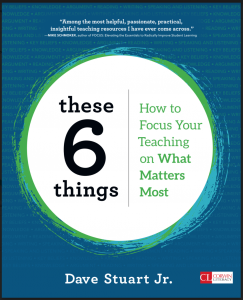Hi there! Thank you for visiting this page. I've just been collecting things here while preparing my talk that I thought might be of interest.
Foundations:
- Writing: The Most Underrated Twenty-First Century Skill
- Our One Enduring Standard (and its Two Components)
- The 300-Word Guide to Long-Term Flourishing
- Optimal Pressure
- “You Don’t Need More Time…
- The Case Against Complaining
- Neomania is Making Us Crazier (and Less Effective) Teachers
Part I: Improve Student Motivation
We need our students to do the writing and to do it with care.
- Five Key Beliefs: The Source of Abbe’s Superpowers
- Not Just Home Life: A Critical Mass of Belief-Supporting Contexts
- Ms. Blizzard and the Potential Weight of Single Interactions
- The (Mis)behaviors that Undermine Our Credibility
- The Five Questions Our Students Are Asking, All the Time
- Learning ≠ Turning On a Video
- The #1 Place in School Where Students’ Key Beliefs are Shaped
From other websites:
I also have an all-online, schedule-friendly course on student motivation — the next session opens in mid-May. Here is the waitlist.
Part II: Increase Quantity
- Why Write?
- Give Me a Number
- Quantity, then Quality
- The Pyramid of Writing Priorities
- Want More Writing Across the Content Areas? Validate the Content
Part III: Increase Quality
Things we can do before we even touch a stack of papers
- Grading ≠ Feedback, and Sometimes You Don’t Need to Do Either
- Exemplars, Sentence Templates, and Checks for Understanding
Here are some ideas about this from conference co-chair Judy Hansen. As Judy said when she shared these with me, “feel free to use them or ignore them.” I'm sharing them because they are all ways to help our students improve the quality of their writing without us handling stacks of papers:
- I have students bring two different introductions for the same essay printed out on separate sheets in 16 point font. We set these out on tables throughout the room. We read and star our favorite of the two and make comments right on the paper.
- Same kind of activity for a research proposal.
- For an essay on a significant place, their first part of the assignment is to visit the place and take notes about everything they experience with their 5 senses. In class, we do a “speed dating” activity where we have an inner and outer circle. They tell their circle partner about the place and the most interesting things they experienced. After a few minutes, the inner circle rotates and they get a new partner.
- When they have their first researched essays ready to turn in, I have them pass their papers two to the right and check another classmate’s in-text citations and works cited page against a checklist. The writer then has an opportunity to make corrections before turning the paper in for a grade. This saves me a LOT of correcting time and they are becoming more proficient at the same time.
Get smarter about feedback and grading
- Teacher's Guide to Satisficing
- Skull and Crossbones Lists
- Common Student Hang-ups: Quote Bombing
- Better and Saner Grading Tip: Get Out the Stopwatch
- Better and Saner Grading Tip: Stop “Relaxing” While Grading
- Better and Saner Grading Tip: Start with the End
A few last things
Book
I've got a book out in July, published by Corwin Literacy, and it's called These 6 Things: How to Focus Your Teaching on What Matters Most. If you'd like to be updated on that book's progress specifically (and help me get the word out there), get on this list.
Also, psst, don't tell anybody, but here's the latest mock-up of the cover:

Newsletter
I publish blog articles twice per week, every Tuesday and Saturday. If you'd like these posts, fresh from my brain to yours, in your inbox, sign up here.
Contact
To be in touch, use my email, which is on your handout
